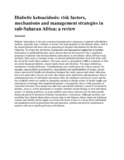| dc.description.abstract | Background: Diabetic ketoacidosis is the most common hyperglycaemic emergency in patients with diabetes mellitus, especially type 1 diabetes. It carries very high mortality in sub-Saharan Africa, both in the treated patients and those who are presenting to hospital with diabetes for the first time.
Objective: To review the risk factors, mechanisms and management approaches in diabetes ketoacidosis in published literature and to discuss them in the context of why a significant proportion of patients who develop diabetic ketoacidosis in sub-Saharan Africa still have high mortality.
Data source: Literature review of relevant published literature from both Africa and the rest of the world.
Data synthesis: The main causes or precipitants of DKA in patients in SSA are newly diagnosed diabetes, missed insulin doses and infections. The major underlying mechanism is insulin deficiency. Treated patients miss insulin doses for various reasons, for example, inaccessibility occasioned by; unavailability and unaffordability of insulin, missed clinics, perceived ill-health and alternative therapies like herbs, prayers and rituals. Infections also occur quite often, but are not overt, like urinary tract, tuberculosis and pneumonia. Due to widespread poverty of individuals and nations alike, the healthcare systems are scarce and the few available centres are unable to adequately maintain a reliable system of insulin supply and exhaustively investigate their hospitalised patients. Consequently, there is little guarantee of successful outcomes. Poor people may also have sub-optimal nutrition, caused or worsened by diabetes, more so, at first presentation to hospital. Intensive insulin therapy in such individuals mimics ‘re-feeding syndrome', an acute anabolic state whose outcome may be unfavourable during the period of treatment of diabetic ketoacidosis.
Conclusions: Although mortality and morbidity from diabetic ketoacidosis remains high in sub-Saharan Africa, improved healthcare systems and reliable insulin supply can reverse the trend, at least, to a large extent. Individuals and populations need empowerment through education, nutrition and poverty eradication to improve self-care in health and living with diabetes | en |

